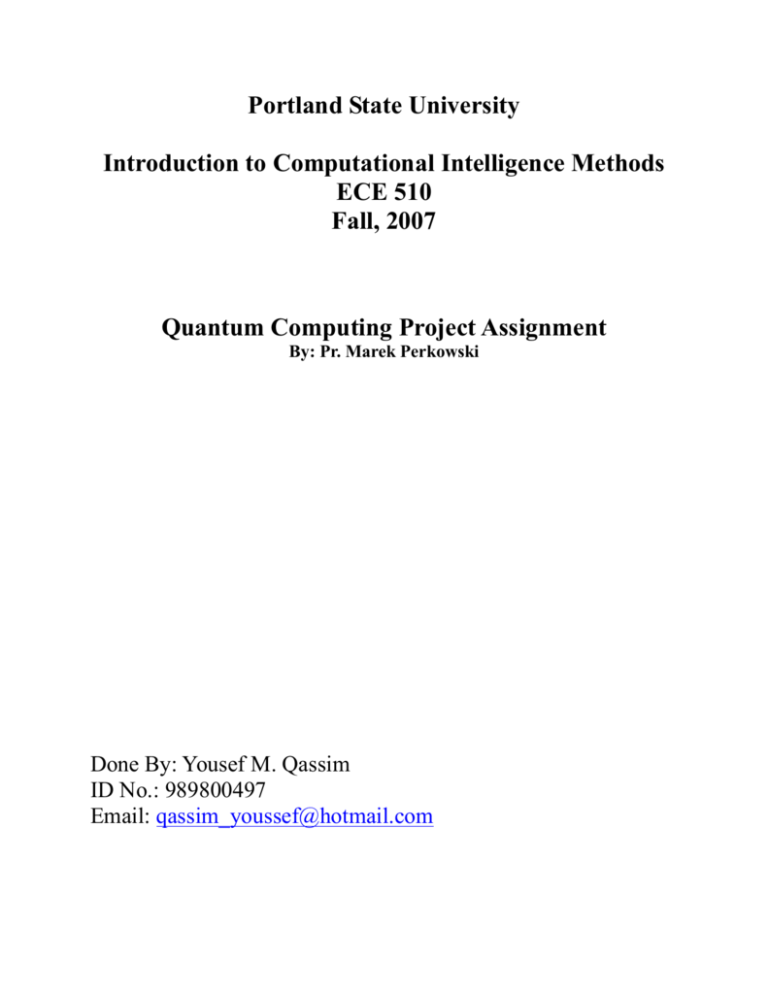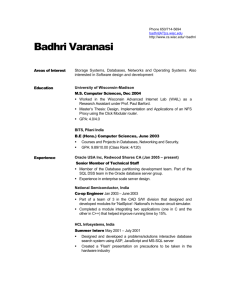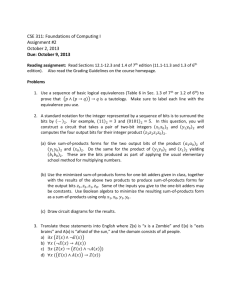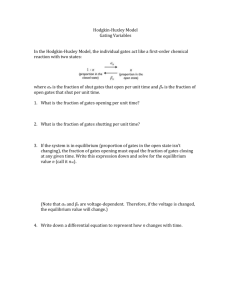Another project - Portland State University
advertisement

Portland State University Introduction to Computational Intelligence Methods ECE 510 Fall, 2007 Quantum Computing Project Assignment By: Pr. Marek Perkowski Done By: Yousef M. Qassim ID No.: 989800497 Email: qassim_youssef@hotmail.com Project Description: Design an oracle for plane graph coloring using quantum computing. The oracle will be designed using gates like Feyman, Hadamard, and Toffoli. We will going to use Grover algorithm to explore all the possible combinations. The Grover algorithm will produces (0s) which indicates bad coloring, and some values for good coloring. Graph coloring: The following graphs explain the idea of the project we are going to design and what the stages we are going to design. Fig1 shows the stages of the design using quantum computer which we are going to apply on the graph coloring problem. The first stage is the input vector which consists of basic inputs and the working bits. The second is combination of Hadamard gates and unity circuits used for exploring all possible combination of inputs at the same time. The third stage is representing the Grover algorithm which is the product of the following equation G=HZHO. Where H is presented as the second block Z is present the zero state phase shift and O is the oracle each of these stages will be explained. Fig2 shows a simple graph coloring of 4 nodes in our case we are going to consider 3 nodes graph coloring. Vector of Basic States& Working bits (In) Vector of Hadamard gates and unity for working bits (H) Grover algorithm G=HZHO Vector of Output Other Gs Blocks ………… (G) Fig1: shows a block diagram of graph coloring problem Fig2: Simple graph coloring of 4 nodes. (Out) Fig3 shows the circuit of the oracle using normal digital gates. As we said we are going to consider just 3 nodes in our case so the graph will be reduced to 3 comparators rather than 5 comparators. Fig4 shows the circuit of a comparator using normal digital gates. Color for node1 Color for node2 Color for node3 Color for node4 Fig3: Shows the circuit of the oracle using digital computer gates. a0 b0 a1 b1 Fig4: The circuit of the comparator in Fig3. Some Famous Circuits and Gates: Here some of famous gates and circuits used in quantum computing. There are other kinds of gates but I’m not going to list it here, other gates like Toffoli, phase shift, etc. Hadamard Gate Vector of Basic States and Working Bits (In): This vector is created by taking the kronecker multiplication between inputs. The first 6 bits are set to Zero from the definition of Grover algorithm these bits define the color of each node 2-bits for each node. The last 4 bits are the working bits (ancilla bits) first 3-bits set to 1 and the last bit are set to zero. We will call this vector In and will be in form of [m*1] where m=210. 1 0 1 0 1 0 1 0 1 0 1 0 0 1 0 1 0 1 1 0 Vector of Basic States& Working bits (In) Vector of Hadamards and Unity of working Bits (H): This Vector is created by kronecker multiplication between Hadamard gates and unity circuits (wires) for working bits. For exploration of all possible states of inputs we follow each input with Hadamard gate. We will call this vector H and will be in form of [m*m]. Vector of Hadamard gates and unity for working bits (H) Fig5: Shows the Hadamard vector. Oracle Design (O): Here we are going to design the oracle for 3 nodes graph coloring using quantum computer gates. As we can see in Fig6, we use Feyman gates, inverse gates, 2-iputs Toffoli gates, and 3-inputs Toffoli gate in constructing the oracle. We also should notice that we are going to use the swap gates to resolve wire crossover problems. We will call the oracle (O). ao a1 bo b1 co c1 1 1 1 0 Fig6: Shows a design of the oracle (O). Fig7: Shows the detailed design of the oracle. We show the detailed design of the oracle in Fig7. We divide the oracle for 4 stages each stage divided into number of units. Each unit can be obtained by applying kronecker multiplication between its components. The oracle will be represented as the reverse matrix multiplication of its stages. The following equations define the oracle circuit (O), and O will be in form of [m,m]. Or, While, Therefore we can write, Grover Algorithm (G): Here we are going to construct the G block from Fig1. As we mention G is constructing by using the following formula. G=HZHO We are going to define Z while H & O previously had been discussed. The Z is short for Zero State Phase Shift. Which represented by Identity (unity) matrix of size [m*m] and replacing the first (1) with (-1). The Grover algorithm uses the equation where O: Inverts the solution states, and HZH: Invert all states about the mean. We are going to apply the block G for N times; where N= and n equal to number of inputs in our case we have 2-bit for each node so we have 6-bit input. By applying N= we get N=8. After applying Grover algorithm 8 times we should see that all possible solutions start having high probabilities close to one, and all bad (wrong) solutions start having probabilities close to zero. The reason of having many solutions with high probabilities is because graph coloring problem have many good solutions. MATLAB: We are going to use the MATLAB to construct all the gates and all the blocks described above. We are going to use the matrix notation. First we are going to define all gates we are going to use in the design. Then next we are going to construct each block using these gates. After that we are going to apply the Grover algorithm on the design. Finally we will make comments on the results. For details, look at the attached file “.m” or at the end of report in the hard copy. Simulation Results: The results had been visualized for better understanding and easier reading for the results. As we know that the Output (Out) is a matrix of size [m*1] where m=1024. We mention in previous sections that result will be represented as high probability values close to (1) for all solutions that give us a good coloring, and low probability values close to (0) for all solutions that give us a bad coloring. The results are presented in Fig8 and Fig9. Fig8 shows the case where we applied G 3-times, and Fig9 shows the case where we applied G 8-times. Fig8: Shows the results of applying Grover block 3-times. Fig9: Shows the results of applying Grover block 8-times. From previous results we can notice that Grover algorithm work correctly; we can see that there are some matrix indexes have higher values than other indexes. Those matrix indexes with high values indicate where all possible solutions are, and the indexes with low values indicate where all bad solutions are. Also we could notice from these figures that increasing the number of G blocks refine the results quality. So we can say that applying the design or the oracle to different number of G blocks affect the quality of result. For more results, what could be done is simply changing the variable (NoG) inside .m file which control the number of G blocks will be applied. Appreciating Notes: Prof. M. Perkowski: I appreciate your patient, kind, comments, and your time. Kiren: Thank you for your tips and your help.





